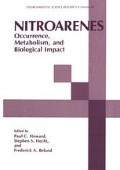Abstract
The carcinogenic activities of the arylamines have been linked to the abilities of the target tissues to transform these agents to derivatives that are capable of reacting with nucleic acid. Thus, the O-esterification of arylhydroxylamines and arylhydroxamic acids has been related to the production of C8 substituted guanine adducts and the subsequent formation of tumors (King, 1985). An important objective of attempts to elucidate the molecular mechanisms involved in tumorigenesis is the exploration of the extent to which these adducts perturb the processing and function of the DNA. The distortion imposed on DNA structure by bulky adducts can be manifested by mutagenic responses and changes in the metabolic disposition of the DNA (Singer and Grunberger, 1983). We have approached these phenomena in two ways by use of extrachromosomal DNA in E. coli cells. C8 adducts of 2-aminofluorene or 4-aminobiphenyl, and their N-acetylated derivatives have been studied (Figure 1). Our objectives have been to develop systems that might be used for comparison of structural differences on the mutagenic effects of site-specific arylamine DNA adducts and the biochemical effects these adducts have on DNA metabolism. Randomly modified DNA has been used in experiments designed to explore the effects of randomly introduced adducts on the ability of these vectors to be replicated, as well as mutagenic consequences. Single, site specific adducts have been employed to determine their mutagenic potentials.
Access this chapter
Tax calculation will be finalised at checkout
Purchases are for personal use only
Preview
Unable to display preview. Download preview PDF.
References
Ames, B.N., Gurney, E.G., Miller, J.A. and Bartsch, H., 1973, Carcinogens as frameshift mutagens: metabolites and derivatives of 2-acetylamino-fluorene and other aromatic amine carcinogens. Proc. Natl. Acad. Sci., USA, 72:1254.
Bichara, M. and Fuchs, R.P.P., 1985, DNA binding and mutation spectra of the carcinogen N-2-aminofluorene in E. col. A correlation between the conformation of the premutagenic lesion and the mutational specificity, J. Mol. Biol., 183:341.
Burnoff, D., Koehl, P. and Fuchs, R.P.P., 1989, Single adduct mutagenesis: strong effect of the position of a single acetylamino-fluorene adduct within a mutation hotspot, Proc. Natl. Acad. Sci., USA, 86:4147.
Fuchs, R.P.P., Koffel-Schwartz, N. and Daune, M., 1981. Hotspots of frameshift mutations induced by the ultimate carcinogen N-acetoxy-N-2-acetylaminofluorene, Nature, 294:657.
Gupta, P.K., Johnson, D.L., Reid, T.M., Lee, M-S, Romano, L.J. and King, C.M., 1989, Mutagenesis by single site specific arylamine DNA adducts: Induction of mutations at multiple sites, J. Biol. Chem., in press.
Gupta, P.K., Lee, M-S, and King, C.M., 1988, Comparison of mutagenesis induced in single-and double-stranded M13 viral DNA by treatment with N-hydroxy-2-aminofluorene, Carcinogenesis, 9:1337.
Johnson, D.L., Reid, T.M., Lee, M-S, King, C.M., and Romano, L.J., 1986, Preparation and characterization of a viral DNA molecule containing a site specific 2-aminofluorene adduct: A new probe for mutagenesis by carcinogens. Biochemistry, 25:449.
Johnson, D.L., Reid, T.M., Lee, M-S, King, C.M., and Romano, L.J., 1987, Chemical stability of oligonucleotides containing the acetylated and deacetylated adducts of the carcinogen N-2-acetylaminofluorene, Carcinogenesis, 8:619.
King, C.M., 1985, Metabolism and the “Initiation” of tumors by chemicals, in: “Arachidonic Acid Metabolism and Tumor Initiation”, L.J. Marnett ed., Martinus Nijhoff Publishing, Boston.
Koffel-Schwartz, N., Maenhaut-Michel, G. and Fuchs, R.P.P., 1987, Specific strand loss in N-2-acetylaminofluorene modified DNA, J. Mol. Biol., 193:651.
Koffel-Schwartz, N., Verdier, J.M., Bichara, M., Freund, A.M., Daune, M.P. and Fuchs, R.P.P., 1984, Carcinogen induced mutation spectrum in wild type, uvrA and umuC strains in E.coli: strain specificity and mutation prone sequences, J. Mol. Biol., 177:33.
Lasko, D.D., Harvey, S.C., Malaikal, S.B., Kadlubar, F.F. and Essigmann, J.M., 1988, Specificity of mutagenesis by 4-aminobiphenyl, J. Biol. Chem., 263:15429.
Lee, M-S. and King, C.M., 1981, New synthesis of N-(guanosin-8-y1)-4-amino-biphenyl and its 5’-monophosphate, Chem. Biol. Interact., 34:239.
Mitchell, N. and Stohrer, G., 1986, Mutagenesis originating in site-specific DNA damage, J. Mol. Biol., 191:177.
Moriya, M., Takeshita, M., Johnson, F., Peden, K., Will, S. and Grollman, A P, 1988, Targeted mutations induced by a single acetylaminofluorene DNA adduct in mammalian cells and bacteria, Proc. Natl. Acad. Sci., USA 85:1586.
Reid, T.M., Lee, M-S and King, C.M., 1990, Mutagenesis by site-specific arylamine adducts in plasmid DNA: Enhancing replication of the adducted strand alters mutation frequency, Biochemistry. In press.
Singer, B. and Grunberger, D., 1983 “Molecular Biology of Mutagens and Carcinogens” Plenum Press, New York.
Tamura, N. and King, C.M., 1990, Comparative survival of aminobiphenyl and aminofluorene substituted plasmid DNA in Escherichia coli Uvr endonuclease deficient strains, Carcinogenesis, 11: No.4, in press.
Tang, M-S, Lieberman, M.W. and King, C.M., 1982, Uvr genes function differently in repair of acetylaminofluorene and aminofluorene DNA adducts, Nature, 299:646.
Author information
Authors and Affiliations
Editor information
Editors and Affiliations
Rights and permissions
Copyright information
© 1990 Springer Science+Business Media New York
About this chapter
Cite this chapter
King, C.M., Reid, T.M., Tamura, N., Gupta, P.K. (1990). Mutagenic and Biochemical Consequences of the Reaction of Arylamines with DNA. In: Howard, P.C., Hecht, S.S., Beland, F.A. (eds) Nitroarenes. Environmental Science Research, vol 40. Springer, Boston, MA. https://doi.org/10.1007/978-1-4615-3800-4_8
Download citation
DOI: https://doi.org/10.1007/978-1-4615-3800-4_8
Publisher Name: Springer, Boston, MA
Print ISBN: 978-1-4613-6694-2
Online ISBN: 978-1-4615-3800-4
eBook Packages: Springer Book Archive

